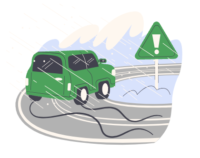Here’s everything you need to know about car insurance for colder weather and a few tips for winterizing your vehicle.
1. Review Your Coverage Before the Snow Hits
Winter weather brings its own set of driving risks, from icy roads to fender benders in slippery parking lots. Before the snow starts falling, it’s a good idea to take a close look at your car insurance policy to ensure you have the right coverage in place.
- Comprehensive Coverage: This coverage is essential during the colder months. It protects your car from damage caused by things like falling tree branches, hailstorms, or even theft while your car is parked.
- Collision Coverage: Slippery roads increase the risk of accidents. Collision coverage helps pay for repairs to your car if you hit another vehicle or object during a snowstorm or icy commute.
- Liability Coverage: Accidents happen, especially when road conditions get tough. Make sure you have enough liability coverage to protect yourself if you’re found at fault for causing damage to someone else’s vehicle or property.
If you’re unsure whether you have these types of coverage, now’s the perfect time to reach out to your insurance agent for a quick review. You want to be certain you’re fully protected before the winter weather arrives. 
2. Consider Roadside Assistance
Winter breakdowns are no fun—whether it’s a dead battery in freezing temperatures, a flat tire in the snow, or getting stuck in an icy patch. Having roadside assistance as part of your car insurance policy can be a lifesaver when you’re facing the elements.
Roadside assistance can help with:
- Towing your vehicle if you get stuck
- Jump-starting a dead battery
- Changing a flat tire
- Unlocking your car if you’re locked out
If your current policy doesn’t include roadside assistance, it might be worth adding, especially with the colder weather ahead.
3. Uninsured/Underinsured Motorist Coverage
Winter weather can lead to more accidents, and not everyone on the road is properly insured. Uninsured/underinsured motorist coverage protects you if you’re hit by someone who doesn’t have enough insurance to cover the damage. This coverage is especially important when driving conditions are more dangerous and accident risks increase.
4. Winterize Your Vehicle for Safer Driving
While insurance is there to protect you financially, taking steps to winterize your vehicle can help prevent accidents and keep you safe on the road. Here are a few tips to get your car ready for the colder months:
- Check Your Tires: Make sure your tires have plenty of tread and are properly inflated. You may even want to consider switching to winter tires if you frequently drive in snowy or icy conditions.
- Test Your Battery: Cold weather can be hard on car batteries. Have your battery tested to make sure it’s fully charged and ready to go when temperatures drop.
- Inspect Your Wipers and Fluid: Winter weather calls for clear visibility. Check your windshield wipers and top off your washer fluid with a winter blend to help prevent freezing.
- Pack an Emergency Kit: Keep a winter emergency kit in your car with essentials like a blanket, flashlight, ice scraper, and snacks in case you get stranded.
5. Drive Safely in Winter Conditions
Even with the best insurance and a well-prepared car, winter driving requires extra caution. Follow these tips to stay safe on the road:
- Slow Down: Snow and ice can reduce traction, so take it slow and give yourself extra time to stop.
- Increase Following Distance: Leave plenty of space between you and the car in front of you to allow for unexpected stops or slides.
- Avoid Sudden Moves: Sudden acceleration, braking, or sharp turns can cause your car to skid. Make smooth, gradual movements when driving on slick roads.
6. Keep Your Insurance Agent in the Loop
Did you recently move or change where you park your car during the winter months? It’s important to let your insurance agent know about these changes. For example, if you’ve started parking in a garage instead of on the street, it could affect your premium. Keeping your agent informed helps ensure that you have the right coverage for your specific situation.
We’re Here to Help!
At Midwest Certified Insurance Agency, we know that winter driving can be stressful, but having the right car insurance coverage can make all the difference. If you have any questions about your policy or want to review your coverage before the cold weather sets in, we’re here to help.
Stay warm, stay safe, and drive carefully this winter!
